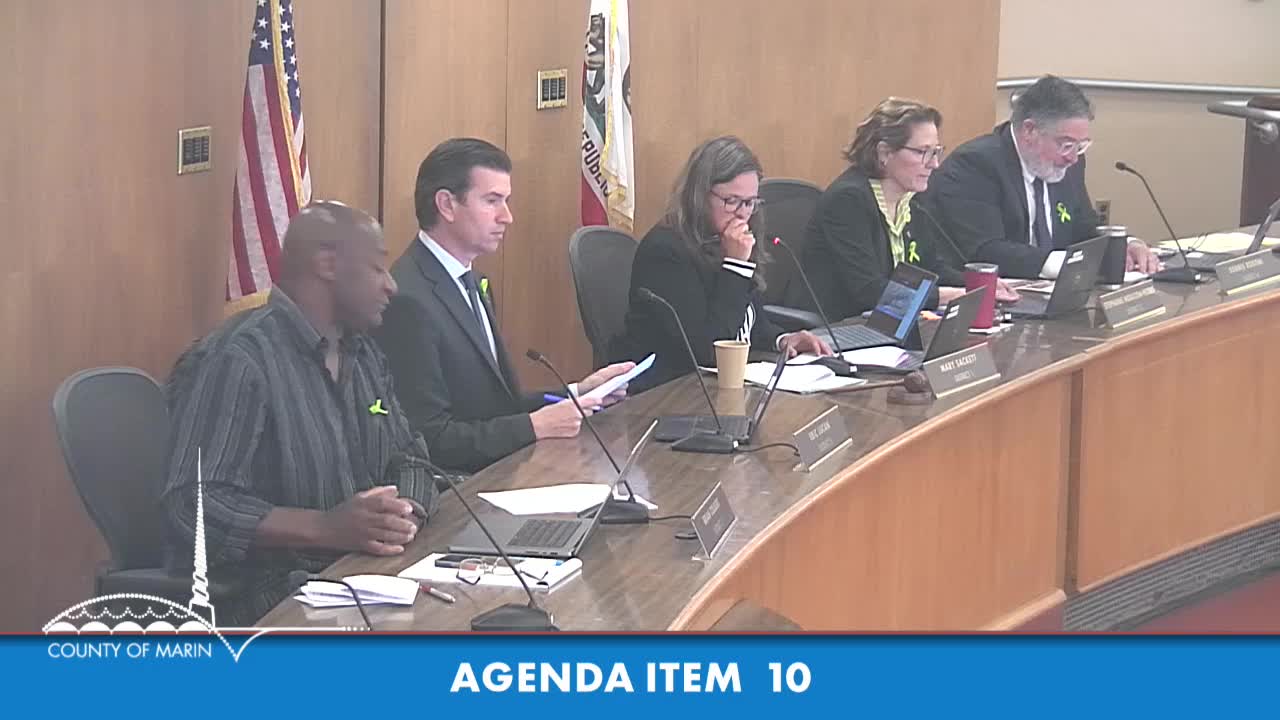Marin County outlines fire-season preparations and moves to adopt updated fire-hazard maps; emergency code revisions introduced
April 23, 2025 | Marin County, California
This article was created by AI summarizing key points discussed. AI makes mistakes, so for full details and context, please refer to the video of the full meeting. Please report any errors so we can fix them. Report an error »

Marin County Fire Chief Jason Weber and Emergency Management Director Steven Torrance briefed the Board of Supervisors on April 22 about fire-season preparedness, large-scale vegetation management, and proposed local code updates to reflect state guidance.
Weber summarized recent investments and capacity gains since major regional fires, including increased crew staffing for initial attack and an expanded fuels program. "We have 30 plus firefighters that are added to every response in this county now that we didn't have before," he said, and he outlined work on fuels reduction, community outreach and detection systems.
Chief Weber and staff emphasized household actions—home hardening and defensible space—as primary risk-reduction steps and noted county programs for inspections, grants and community-level fuel-reduction projects. He described a countywide defensible-space inspection program and urged residents to treat the first five feet around structures as a priority for home-hardening efforts.
Board action and ordinances: The board voted to acknowledge Wildfire Awareness Week. Supervisors then introduced (first reading) an ordinance to adopt updated Fire Hazard Severity Zone maps for the county local responsibility area (LRA). The presentation explained that the updated maps add high and moderate hazard categories for LRA lands and that the maps are a hazard-designation tool (30–50 year projections focused on ember exposure and propagation). Chief Weber and staff emphasized the maps are not a building moratorium, but that state-required building codes (for example, Chapter 7A standards) and disclosure requirements will interact with the maps.
Emergency management revision: Director Torrance presented proposed revisions to section 2.99 of the county municipal code to align county emergency organization and authorities with state and federal guidance. The revisions reintroduce the term "director of emergency services" (to be held ex officio by the county executive), create an "assistant director of emergency services" role, and clarify procurement and expenditure procedures during declared emergencies. The board introduced the ordinance for first reading and placed final adoption on the May 6 consent calendar.
Why it matters: Officials said improved staffing, fuel-reduction work, and outreach are strengthening the county’s ability to respond, but they cautioned that weather, fuels and statewide conditions will affect risk. Supervisors discussed neighbors’ compliance, management of unmanaged parcels, and options to help residents complete home-hardening work, including grant programs and vetted contractors.
Next steps: County staff plan continued outreach, adjustments to grant programs to stretch funds, coordination with city/town fire agencies, and additional ordinance and code work to be returned to the board as state guidance is finalized.
Weber summarized recent investments and capacity gains since major regional fires, including increased crew staffing for initial attack and an expanded fuels program. "We have 30 plus firefighters that are added to every response in this county now that we didn't have before," he said, and he outlined work on fuels reduction, community outreach and detection systems.
Chief Weber and staff emphasized household actions—home hardening and defensible space—as primary risk-reduction steps and noted county programs for inspections, grants and community-level fuel-reduction projects. He described a countywide defensible-space inspection program and urged residents to treat the first five feet around structures as a priority for home-hardening efforts.
Board action and ordinances: The board voted to acknowledge Wildfire Awareness Week. Supervisors then introduced (first reading) an ordinance to adopt updated Fire Hazard Severity Zone maps for the county local responsibility area (LRA). The presentation explained that the updated maps add high and moderate hazard categories for LRA lands and that the maps are a hazard-designation tool (30–50 year projections focused on ember exposure and propagation). Chief Weber and staff emphasized the maps are not a building moratorium, but that state-required building codes (for example, Chapter 7A standards) and disclosure requirements will interact with the maps.
Emergency management revision: Director Torrance presented proposed revisions to section 2.99 of the county municipal code to align county emergency organization and authorities with state and federal guidance. The revisions reintroduce the term "director of emergency services" (to be held ex officio by the county executive), create an "assistant director of emergency services" role, and clarify procurement and expenditure procedures during declared emergencies. The board introduced the ordinance for first reading and placed final adoption on the May 6 consent calendar.
Why it matters: Officials said improved staffing, fuel-reduction work, and outreach are strengthening the county’s ability to respond, but they cautioned that weather, fuels and statewide conditions will affect risk. Supervisors discussed neighbors’ compliance, management of unmanaged parcels, and options to help residents complete home-hardening work, including grant programs and vetted contractors.
Next steps: County staff plan continued outreach, adjustments to grant programs to stretch funds, coordination with city/town fire agencies, and additional ordinance and code work to be returned to the board as state guidance is finalized.
View full meeting
This article is based on a recent meeting—watch the full video and explore the complete transcript for deeper insights into the discussion.
View full meeting
